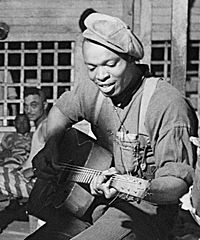Buddy Moss facts for kids
Quick facts for kids
Eugene "Buddy" Moss
|
|
|---|---|

Moss in 1941
|
|
| Background information | |
| Birth name | Eugene Moss |
| Also known as | Buddy Moss |
| Born | January 16, 1914 Jewell, Georgia, US |
| Died | October 19, 1984 (aged 70) Atlanta, Georgia |
| Genres | Blues |
| Occupation(s) |
|
| Instruments |
|
| Years active | 1930–1976 |
| Labels |
|
Eugene "Buddy" Moss (born January 16, 1914 – died October 19, 1984) was an American blues musician. He was a very important Piedmont blues guitarist. He recorded music between 1932 and 1935, a time when other famous blues artists like Blind Blake and Blind Boy Fuller were also active.
Buddy Moss was part of a group of blues musicians in Atlanta, Georgia. He learned a lot from artists like Blind Blake. His music career stopped for a while in 1935 when he faced legal trouble. It was also paused by World War II. Luckily, he was rediscovered in the 1960s and continued to share his amazing talent.
Some people say Buddy Moss was influenced by his friend and bandmate, Barbecue Bob. Others believe Blind Blake taught him a lot. It's even thought that Buddy Moss might have influenced Blind Boy Fuller, even though they never met.
Contents
The Life of Buddy Moss
Growing Up
Buddy Moss was one of 12 children. He was born in Jewell, Georgia, a small town in Warren County. His family were sharecroppers, meaning they farmed land owned by someone else.
When he was four, his family moved to Augusta, Georgia. He started teaching himself to play the harmonica at a very young age. He would play at local parties. By 1928, he was playing music on the streets of Atlanta. He once said he learned by listening to others.
Starting His Music Career
When Buddy Moss arrived in Atlanta, older musicians like Curley Weaver and Barbecue Bob noticed him. They helped him get his first chance to record music. In 1930, when he was 16, he recorded four songs with their group, the Georgia Cotton Pickers. He played the harmonica on these songs for Columbia Records.
By 1933, Buddy Moss had also taught himself to play the guitar. He often played with Barbecue Bob until Bob passed away in 1931. After that, Moss started playing with Blind Willie McTell at parties around Atlanta.
In January 1933, Buddy Moss recorded his own songs for the first time in New York City. He played with Fred McMullen and Curley Weaver. He recorded 11 songs, which were all released. He also played harmonica with a group called the Georgia Browns. His songs became very popular in the southern United States.
In 1934, he recorded more songs as a solo guitarist and singer. His songs were selling even better than those of Weaver and McTell. One of his songs, "Oh Lordy Mama," became very famous and was later known as "Hey Lawdy Mama." Many other artists have played this song.
Challenges and Comeback
In 1936, Buddy Moss was sent to prison. This stopped his music career for a long time. After another blues musician, Blind Boy Fuller, passed away in 1941, Fuller's manager, J. B. Long, helped Buddy Moss get out of prison. Moss was released on parole, which meant he had to follow certain rules.
While on parole, he met other blues musicians like Sonny Terry and Brownie McGhee. In October 1941, Moss, Terry, and McGhee went to New York City to record more songs. However, World War II soon began. This made it hard to make records because materials like shellac were rationed. Also, a musicians' union stopped its members from recording. This meant Buddy Moss's comeback was cut short.
Later Years and Rediscovery
Buddy Moss kept performing in places like Richmond, Virginia, and Durham, North Carolina, during the 1940s. He also played with Curley Weaver in Atlanta in the early 1950s. But music alone wasn't enough to make a living. He worked many different jobs, like on a tobacco farm or as an elevator operator.
Even though he was a very important blues musician from the 1930s, he was mostly forgotten for a while. Then, in 1964, he heard that his old friend Josh White was playing a concert in Atlanta. Buddy Moss went backstage to see him. Josh White encouraged him to start performing again for college audiences. He also recorded new songs for Columbia Records, but they weren't released until after he passed away.
Buddy Moss performed at several music festivals, including the Newport Folk Festival in 1969. He also played at the John Henry Memorial Concert and the National Folk Festival.
His Legacy
Buddy Moss passed away in Atlanta on October 19, 1984. He was largely forgotten by the public again at that time. However, his music has since been re-released by record companies like Biograph Records and Document Records. Thanks to these re-releases, his music is available for new generations to discover. His reputation has grown again, and he is remembered as an important figure in blues music.
Buddy Moss's Music
Albums
- Atlanta Blues Legend (Biograph, 1967) – This album was later re-released in 1970 as Rediscovery.
Collections of Songs

